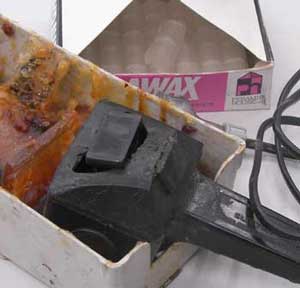Munsell chips
Tones, or values, are more important in representational painting than colour. A strong statement? Think about it – a black & white photo tells you everything you need to know to identify an object, colour just makes it prettier…
 Estimating values is for many the tough part of learning to paint. Squinting helps but even then: what’s what? A value chart gets around that by giving something to measure against. I followed Paul Foxton’s lead and made a set of Munsell “chips” a while back (the bits of wood in the photo) to do exactly that. Using them, by the way, did not turn out to be a crutch for life, as some folks reckon, it was only a matter of months before I was mixing the greys without looking and for the most part even thinking about it. They’re in my head (somewhere…).
Estimating values is for many the tough part of learning to paint. Squinting helps but even then: what’s what? A value chart gets around that by giving something to measure against. I followed Paul Foxton’s lead and made a set of Munsell “chips” a while back (the bits of wood in the photo) to do exactly that. Using them, by the way, did not turn out to be a crutch for life, as some folks reckon, it was only a matter of months before I was mixing the greys without looking and for the most part even thinking about it. They’re in my head (somewhere…).
Now, that’s all very fine when painting from life in the studio or (gasp!) a photo or other reference. Yeah, I do use photos when I need them. For one I paint ’til late (* think 2am…) and there ain’t much out there to see if one is painting landscape. Or in my recent clouds series: not many to be seen in Chittering over the past months. OK, so there’s the occasional fluffy white against the endless blue but not a one of the moody storms I had in mind. Besides, getting on into the series, I needed inspiration cos my plan calls for a hundred studies – I got to 67 before a more urgent project elbowed them aside – I’ll be back. Anyway, on topic, photos rock sometimes and dovetail very nicely with a value chart or chip while learning to see.
However (there is a point to all this), when I switched from using prints to a screen to display my reference (lots of reasons: among them zooming in on detail and way better depth of colour) there was a problem. Holding the chips up to compare to the screen didn’t work because the screen is bright and light and no matter what angle I held the chip to it I couldn’t get a match as I could with the hardcopy.
That’s where a tiny freeware utility called Pixel Pixie came in. What does it do? Simply a small box (on my screen about 4cm wide) floating over the top of any other software that’s running it displays all kinds of colour info – among them HSV. It does other stuff too but that’s what we want right here. The V in HSV stands for value… the value of the pixel at the end of the pointer. Can you see where this is going?
Pixel Pixie screen capture

Read the values off the image, match it to a Munsell chip (or other value chart as you wish) and from there to your paint. Maybe in 10% divisions where, say, everything in the twenties is a value two, or the 50’s a value five etc. This works nicely with Munsell which goes zero for black through to ten for white. Some other value charts have it back to front – no problem – a nice fat red crayon can fix that…
The end result won’t be perfect, of course, because that’s where the art rears it’s head again. Beyond the blocking in of a painting it’s time to “go with the force” (Peter Dailey said that in class once – it still has me chuckling) and adjust to your eye and temperament. It can also be desirable to change values on the fly – raising or lowering the temperature of the painting by mapping to a compressed range. For example, decide that it’s a really moody sky and move everything down to a smaller range of dark colours.
Anyway, have a go, because anything that takes the frustration down a peg or two is worth doing and don’t worry about getting dependent on any tools (photos, chips or software) ‘cos at some point the eye does kick in, especially if you have a guess first, then Pixel Pixie or compare a chip to check it.
Have fun.
Amanda
(* Painting day and night (really should get a life…) offers another problem: colour shifts under different light. I solved the problem with two Daylight lamps: one on the easel and another over the palette table. Works OK. A perfect south facing window – Australia remember – and shorter working hours would be better but neither of those is happening any time soon.)








 Estimating values is for many the tough part of learning to paint. Squinting helps but even then: what’s what? A value chart gets around that by giving something to measure against. I followed
Estimating values is for many the tough part of learning to paint. Squinting helps but even then: what’s what? A value chart gets around that by giving something to measure against. I followed 





